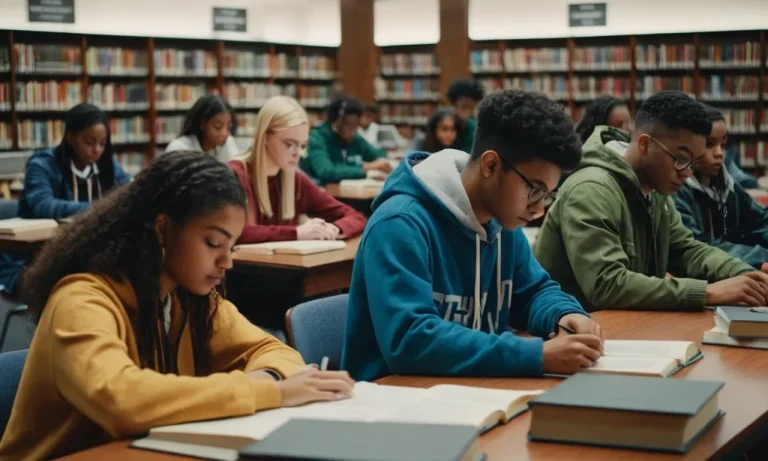Embarking on a gap year during high school is a decision that can shape your personal growth and academic journey. As you navigate the complexities of adolescence and contemplate your future, the idea of taking a break from the traditional educational path may seem enticing, yet daunting.
If you’re short on time, here’s a quick answer to your question: Yes, it is possible to take a gap year during high school, but the process and requirements vary depending on your location, school district, and personal circumstances.
In this comprehensive article, we’ll explore the concept of a high school gap year, its potential benefits and drawbacks, the steps involved in pursuing this path, and the factors to consider before making this significant decision.
Whether you’re seeking personal growth, academic enrichment, or a chance to explore your passions, this guide will provide you with the insights you need to make an informed choice.
Understanding the High School Gap Year
What is a Gap Year?
A gap year, also known as a “year off” or “year out,” is a period of time when students take a break from formal education to pursue other interests or experiences. This concept has been around for decades, but it has gained significant popularity in recent years, particularly among high school students.
According to a survey by the Gap Year Association, over 40% of gap year participants are high school graduates.
Reasons for Taking a Gap Year in High School
- Personal growth and self-discovery: A gap year provides an opportunity for students to explore their passions, gain life experiences, and develop a better understanding of themselves.
- Academic reset: Some students may feel burnt out from the rigors of high school and need a break to recharge before continuing their education.
- Career exploration: A gap year can allow students to try out different jobs or internships, helping them identify potential career paths.
- Cultural immersion: Many students use their gap year to travel and immerse themselves in new cultures, broadening their perspectives and developing global awareness.
Common Gap Year Activities
Gap year activities can vary greatly depending on the student’s interests and goals. Here are some popular options:
- Volunteering or community service: Students can participate in local or international volunteer programs, contributing to meaningful causes while gaining valuable experiences.
- Travel and cultural immersion: Exploring new countries, learning languages, and experiencing different cultures can be an enriching and transformative experience.
- Internships or apprenticeships: Hands-on work experiences can help students develop practical skills and gain insights into potential career paths.
- Personal projects or entrepreneurial ventures: Some students use their gap year to pursue creative endeavors, start a business, or work on personal projects.
It’s important to note that taking a gap year in high school requires careful planning and consideration. Students should research gap year programs, seek guidance from school counselors or gap year advisors, and ensure they meet any necessary requirements for college admission or financial aid.
The Gap Year Association is a great resource for information and advice on gap year opportunities.
Navigating the Process
Consulting with School Authorities
Before embarking on a gap year during high school, it’s crucial to consult with the relevant school authorities. This includes meeting with your guidance counselor, principal, and any other administrators involved in academic planning.
They can provide valuable insights into the school’s policies, requirements, and procedures for taking a gap year. Open communication and transparency are key to ensuring a smooth process and maintaining a positive relationship with the school.
During these consultations, be prepared to discuss your motivations, goals, and plans for the gap year. Share your vision for personal growth, academic enrichment, or any other pursuits you hope to undertake.
School officials may offer guidance on structuring your gap year experience to align with your educational objectives. Additionally, they can advise you on the potential implications of a gap year on your academic standing, course credits, and future college applications.
Obtaining Necessary Approvals
Once you’ve consulted with the school authorities, the next step is to obtain the necessary approvals. This process may involve submitting a formal request or application, providing supporting documentation, and adhering to specific deadlines.
Some schools may require a detailed plan outlining your gap year activities, including any educational programs, internships, or volunteer work you intend to pursue.
It’s important to follow the school’s guidelines and procedures meticulously. Failure to obtain proper approvals could jeopardize your academic standing or result in complications when you return to school.
If you encounter any challenges or have questions during this process, don’t hesitate to seek clarification from the school officials. Their guidance can help ensure a smooth transition before and after your gap year.
Exploring Gap Year Programs and Opportunities
With the school’s approval in hand, you can now explore the myriad of gap year programs and opportunities available. Many organizations, such as Gap Year Association, offer structured programs tailored to high school students.
These programs often combine educational components, cultural immersion experiences, and opportunities for personal growth.
Alternatively, you may opt to design your own gap year experience by combining various activities and opportunities. Consider internships, volunteer work, language immersion programs, or even travel experiences that align with your interests and goals.
Websites like GoAbroad and GoOverseas can be valuable resources for researching and comparing different gap year options.
Remember, a gap year is an opportunity to step outside your comfort zone, challenge yourself, and gain valuable life experiences. Don’t be afraid to think creatively and pursue opportunities that excite you, even if they may seem unconventional.
With proper planning and guidance, a gap year can be a transformative experience that shapes your personal and academic journey in profound ways.
Potential Benefits and Drawbacks
Personal Growth and Self-Discovery
Taking a gap year during high school can be an incredible opportunity for personal growth and self-discovery. By stepping away from the traditional academic path, students gain the chance to explore their interests, passions, and values in a more immersive and hands-on way.
This break can foster independence, resilience, and a deeper understanding of themselves and the world around them. According to a survey by the Gap Year Association, 98% of students who took a gap year reported that it helped them develop as a person.
Academic Enrichment and Exploration
A gap year can also provide valuable academic enrichment opportunities. Students can pursue internships, volunteer work, or educational programs that align with their academic interests, allowing them to gain practical experience and explore potential career paths.
This exposure can help solidify their academic goals and motivate them to excel upon returning to school. A study by the Gap Year Association found that 88% of students who took a gap year had a better sense of their academic and career interests.
Financial Considerations
While taking a gap year may seem financially daunting, it can actually be a cost-effective option in the long run. By delaying college for a year, students and their families can potentially save on tuition, room, and board expenses.
Additionally, many gap year programs offer scholarships or financial aid opportunities. However, it’s crucial to carefully plan and budget for any gap year activities to avoid financial strain. According to a report by CNBC, taking a gap year can save students over $90,000 in tuition and living costs.
Potential Challenges and Risks
While a gap year can offer numerous benefits, it’s important to consider potential challenges and risks. Some students may struggle with the transition back to academic life or face difficulties in re-enrolling at their desired institution.
There are also concerns about safety and well-being during gap year activities, especially when traveling abroad. Additionally, students may face social and emotional challenges, such as feeling disconnected from their peers or experiencing a sense of uncertainty about their future plans.
It’s essential to carefully research and plan for any gap year activities to mitigate these risks. According to a study by Gap Year Association, only 1.6% of students who took a gap year reported significant difficulties in re-enrolling in college.
Making the Most of Your Gap Year
Taking a gap year during high school can be an enriching experience, but it requires careful planning and goal-setting to make the most of it. Here are some tips to help you maximize your time away from the classroom:
Setting Clear Goals and Objectives
Before embarking on your gap year, it’s crucial to define your goals and objectives. Do you want to explore a specific interest or passion? Gain work experience in a particular field? Volunteer or travel? Having clear goals will help you stay focused and make the most of your time.
According to a study by the Gap Year Association (https://www.gapyearassociation.org/), nearly 90% of gap year students reported that their experience helped them develop specific career interests or academic goals.
Developing a Structured Plan
Once you’ve identified your goals, create a structured plan to achieve them. This might include researching opportunities, applying for programs or internships, and budgeting for expenses. Don’t forget to factor in time for personal growth and self-discovery as well.
According to a survey by the American Gap Association (https://www.americangap.org/), 98% of students who took a gap year felt that it helped them develop as a person.
Documenting Your Experiences
Your gap year will be filled with valuable experiences and lessons learned. Consider keeping a journal or blog to document your journey. This will not only help you reflect on your experiences but also provide a record of your growth and accomplishments.
You could even use your documentation to create a portfolio or personal website, showcasing your skills and experiences to potential colleges or employers. 😊
Preparing for Re-entry into High School
As your gap year comes to an end, it’s important to prepare for your re-entry into high school. Stay up-to-date with any changes in academic requirements or policies, and consider reaching out to your school’s guidance counselor for support.
Additionally, reflect on how your gap year experiences have shaped your goals and interests, and be ready to articulate how they have contributed to your personal and academic growth. According to a study by the Gap Year Association, students who take a gap year are often more focused and motivated upon returning to school, leading to higher GPAs and increased engagement in extracurricular activities.
👏
Conclusion
Taking a gap year during high school is a significant decision that requires careful consideration and planning. While it offers opportunities for personal growth, academic enrichment, and self-discovery, it also comes with potential challenges and risks that should be weighed carefully.
By understanding the process, exploring available options, and setting clear goals, you can make the most of your gap year experience. Remember, a well-planned and purposeful gap year can provide invaluable life lessons, broaden your horizons, and ultimately shape your academic and personal journey in profound ways.
Ultimately, the decision to take a gap year during high school is a personal one that should align with your aspirations, values, and long-term goals. Seek guidance from trusted mentors, educators, and professionals to ensure you make an informed choice that aligns with your unique circumstances and aspirations.






